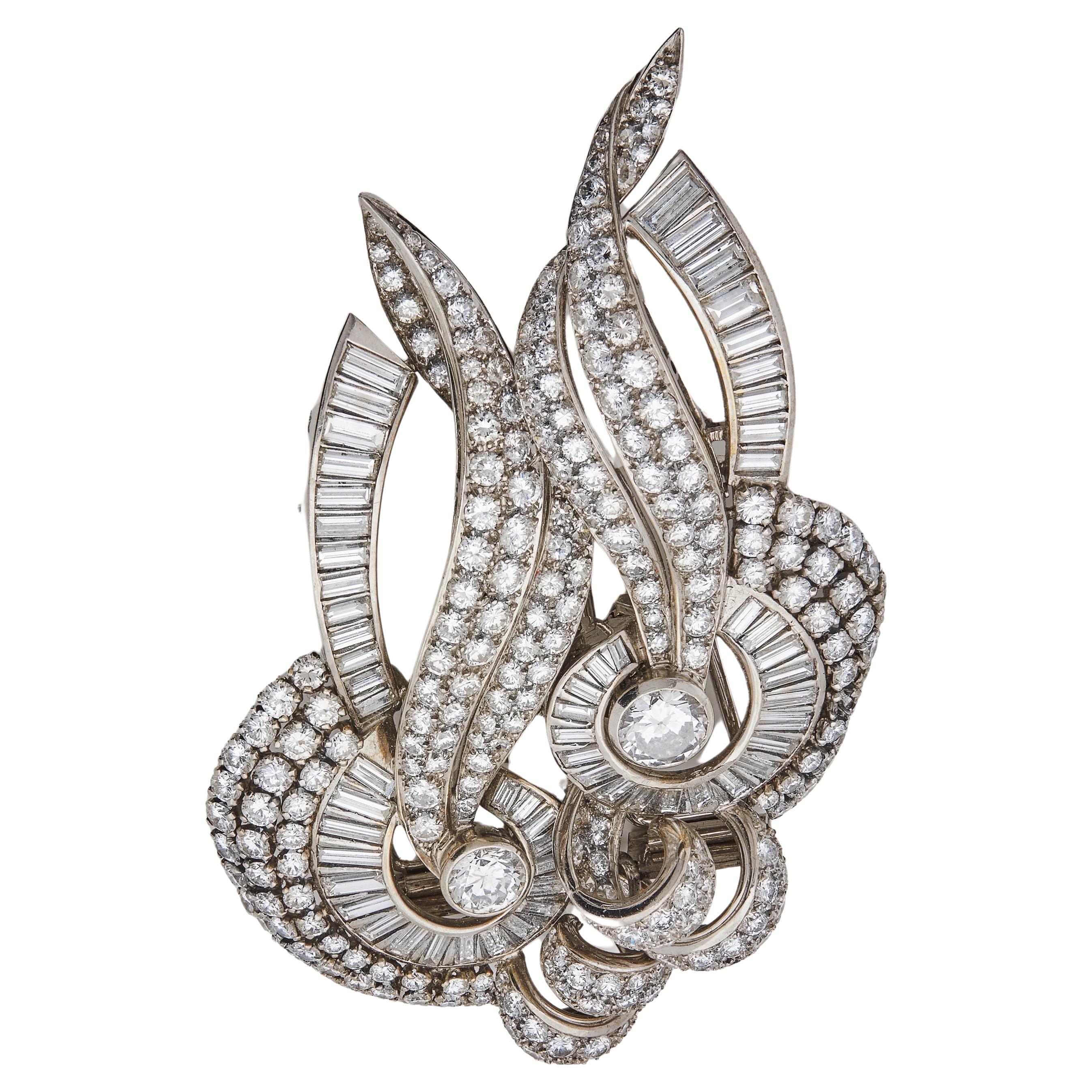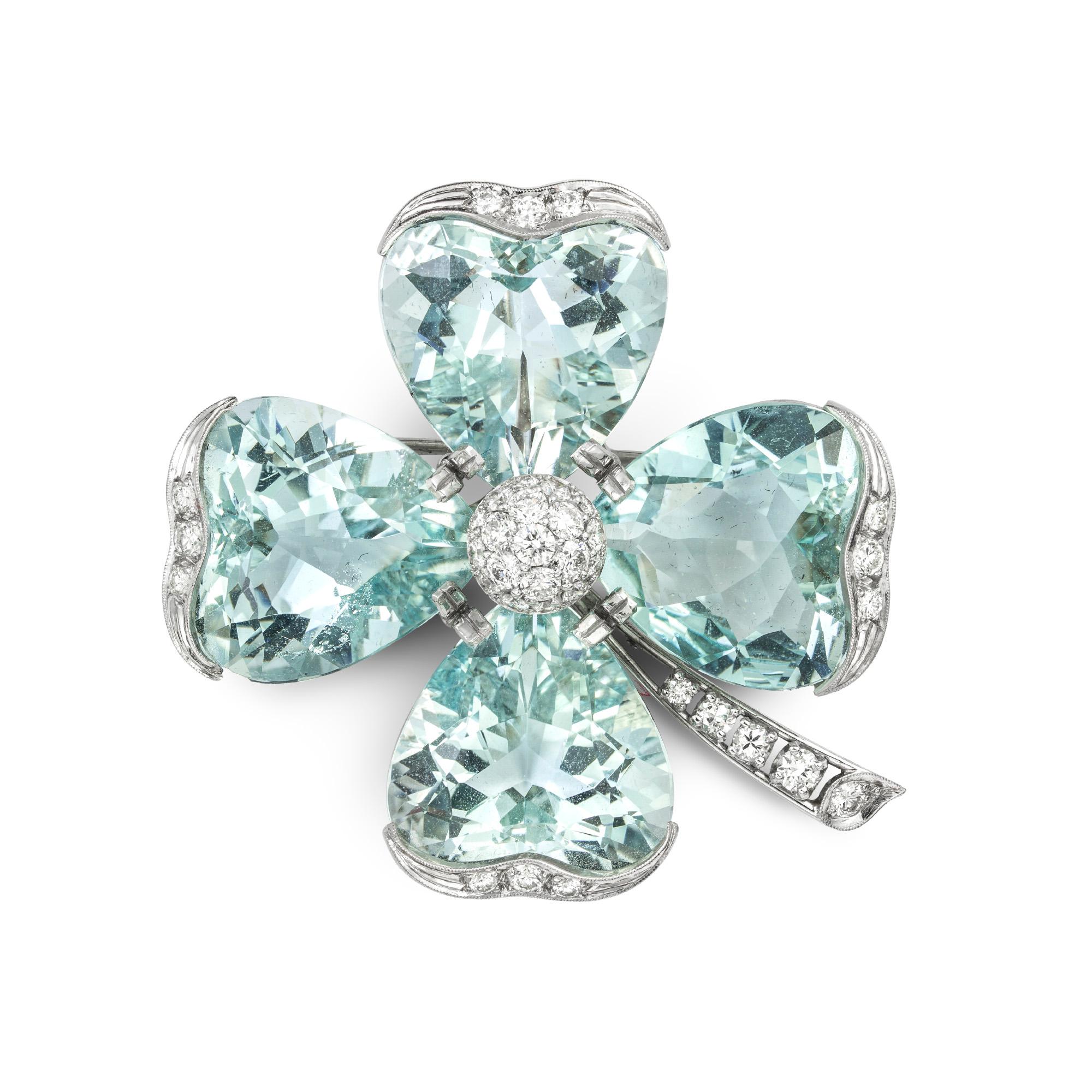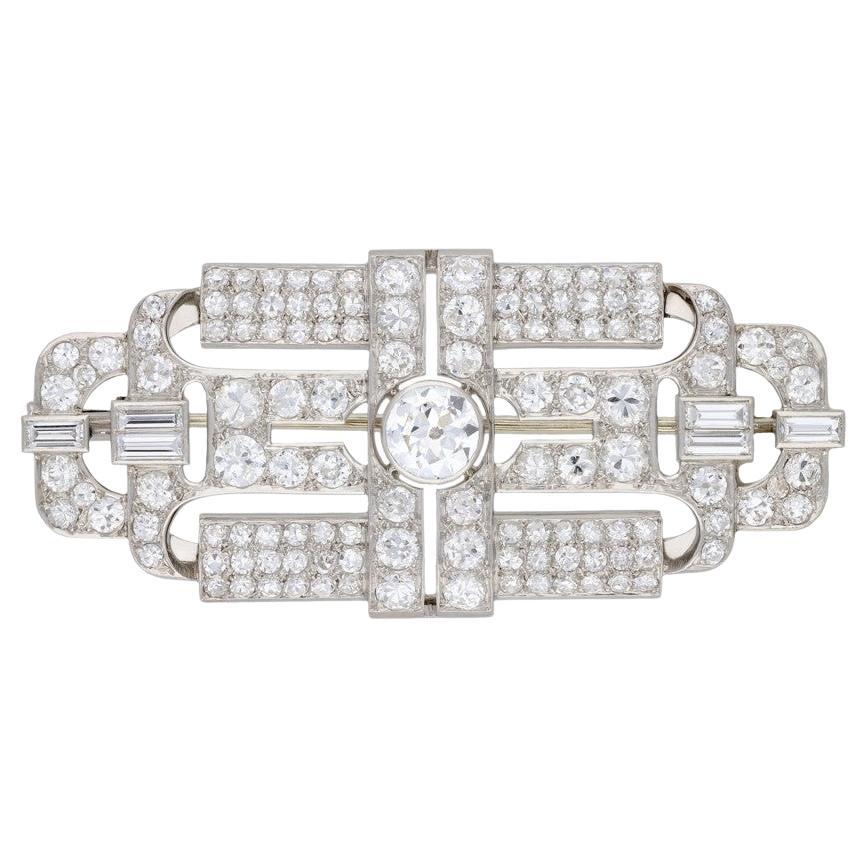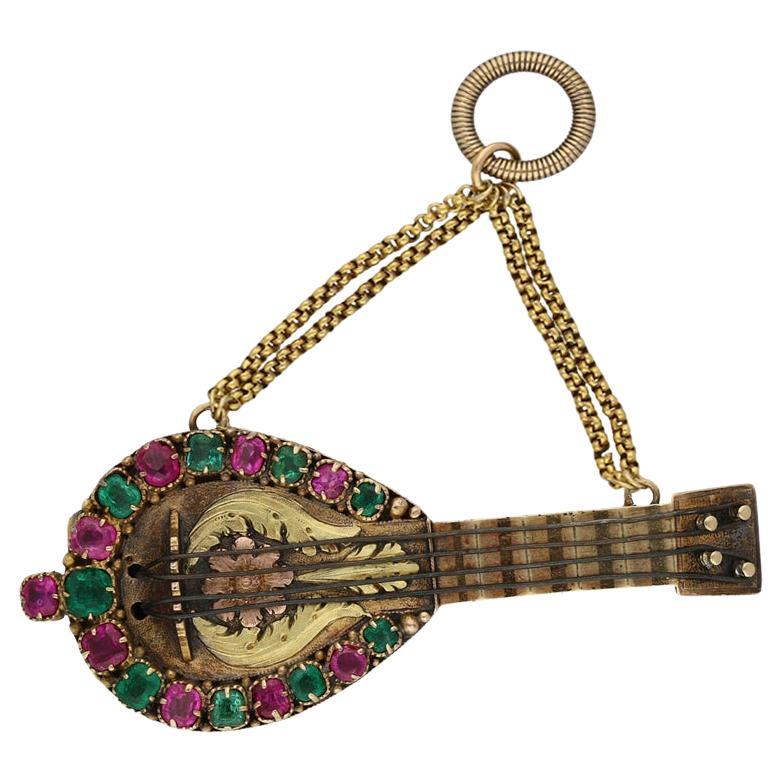Items Similar to Antique FabergeStyle 3AquamarineCabochons 4GreyDiamonds BezelSet Platinum Brooch
Want more images or videos?
Request additional images or videos from the seller
1 of 14
Antique FabergeStyle 3AquamarineCabochons 4GreyDiamonds BezelSet Platinum Brooch
About the Item
This antique Victorian platinum filigree bar-brooch or tie-pin from the Edwardian period in a Faberge style features bezel settings with three square-cut 10mm sugarloaf aquamarine cabochons with indistinct schiller and greenish sheen, plus four brilliant-cut gray diamonds with black inclusions. The last two photos were taken in natural light to best show the chatoyant effects in the open-backed semi-translucent blue stones, which appear like water refractions.
The fine details, arrangement, and combination of bezel settings in our 5.5-cm-long geometric piece strongly resemble the sapphire-and-diamond gold brooch #244 in the hardcover catalogue, Carl Faberge: Goldsmith To The Tsar, that accompanied the Nationalmuseum exhibition in Stockholm, Sweden, in 1997. Enabling light to enter from all around the bottom of the blue stones, the similarly aligned diamond-shaped settings are intricately decorated with serrated rims, as well as with rectangular-openwork filigree and embroidery-like punchwork found on other Faberge brooches before the family fled to Switzerland in war-time 1917. While our brooch is signed on the pin with an indistinguishable linear impression including letters, it is unclear without closeups precisely how the book piece is marked. Dating the brooch craftsmanship between 1896-1908 in St. Petersburg where Russian Cyrillic letters were used to mark Faberge works, the book notes that its brooch marks also included the initials of Faberge work-master Andrej Gorianov and assay-master A. Richter.
Helping to date our brooch to the early 1900s in Europe before the first world war, its C-clasp has a flip-up lever safety catch that was in use around 1900, while the modern safety clasp that soon made it obsolete was invented in 1911. Also, at the beginning of the 20th Century the use of yellow gold in jewelry wained, while interest in platinum and white metals surged.
Given the petit-point punchwork on our brooch that can be associated with the female Faberge jeweler Alma Theresia Pihl--the granddaughter of Faberge principal jeweler August Holmstrom--it is notable that her early works were unmarked or merely included an inventory number, such as her snowflake-inspired jewelry that included platinum. Further, according to the book, Faberge In The Royal Collection, published in London in 2003, her first major project was in 1912 when she created 40 small brooches that were ordered by one of Faberge's best customers Dr. Emanuel Nobel, whereafter the following year she designed her first Imperial Easter Egg.
- Metal:Platinum
- Stone:Diamond,Aquamarine,Black Diamond
- Stone Cut:Mixed Cut
- Weight:4 g
- Dimensions:Height: 0.6 in (15 mm)Width: 2.17 in (55 mm)Depth: 0.6 in (15 mm)
- Style:Edwardian
- Place of Origin:Europe
- Period:1900-1909
- Date of Manufacture:1900-1917
- Condition:Wear consistent with age and use.
- Seller Location:Chicago, IL
- Reference Number:1stDibs: LU3244219432012
About the Seller
5.0
Vetted Seller
These experienced sellers undergo a comprehensive evaluation by our team of in-house experts.
Established in 2012
1stDibs seller since 2022
9 sales on 1stDibs
Typical response time: <1 hour
- ShippingRetrieving quote...Ships From: North Adams, MA
- Return PolicyA return for this item may be initiated within 1 day of delivery.
More From This SellerView All
- Couture CocoChanel Byzantine ThePurpleHeart PearlAmethystQuartz GoldMedallionBy ChanelLocated in Chicago, ILDuring the ArtDeco period when Gabriel "Coco" Chanel was at her peak as a Parisian couture fashion-designer in the early 1930s, this antique one-of-a-kind handcrafted gem-fringed and gilt-chain medallion brooch with trombone clasp was commissioned to accessorize one of her clothing designs. Marked only "FRANCE" like some early 1930s Chanel couture jewelry (without a brand stamp until the 1950s), its artistic origin is most likely from ornate organic-form sketches by her favorite parurer Fulco di Verdura. The Sicilian duke began creating fabric patterns for Chanel in 1927, which shortly expanded to fine jewelry beginning with custom pieces for herself. These include the iconic Byzantine-influenced gem-adorned cuffs referencing the Maltese military-cross, which the French designer can often be seen wearing in circa-1930s photos. This bright yellow-gold brooch suits goldsmith Verdura's early anti-Art-Deco aesthetic that was considered a radical departure from 1920s silver-tone jewelry, which otherwise featured linear geometric designs or figurative representation. The softly-shaped deconstructed gem-bouquet mixes amethyst and rose-quartz beads with natural Keshi pearls and intricate tiny gilt leaves, which are wired to a Baroque-motif open-work frame that dangles another gem surrounded by a thick gilt-rope halo. Notably, Verdura is credited with re-introducing since Victorian times the rope motif to jewelry. Since 1930, Verdura's unique style was influenced by travels with Chanel to explore Byzantine art, Baroque architecture, and exotic flora-and-fauna among his native Italian aristocratic estate. The legendary fashion-editor Diane Vreeland and American entertainment-stars were among the first Chanel clients to acquire couture real-gem-adorned jewelry made by Verdura, while one of the two brooches treasured by Vreeland was titled "Theodora". See our photo of the Byzantine mosaic of Empress Theodora, whose image wearing many teardrop pearls above her chest and surrounded by a golden halo seems to be the inspiration for this brooch. As one of the most important modern-design collaborations, Chanel's close relationship with Verdura lasted largely-undocumented years in Paris, until he launched his first outside jewelry venture with a Hollywood designer-boutique after emigrating to the United States in 1934. By 1939 as a financially-backed in-demand goldsmith, he founded the namesake jewelry-company Verdura in NYC. After he retired in 1973, the brand continued to operate without him with different owners. Given the duo's designs that played with historic and military references, Chanel's couture commission for this purple medallion may have been sparked in the early 1930s when the internationally-new...Category
Vintage 1930s French Brooches
MaterialsAmethyst, Pearl, Quartz, Gold, Gilt Metal, Yellow Gold
- MiriamHaskell c1929 FrankHess Rare FurClips GoldGiltBrass 3ChainFloraBow LariatBy Frank Hess for Miriam HaskellLocated in Chicago, ILAs one of Miriam Haskell's earliest fur clips from the late 1920s, these two Russian-gold gilt mostly brass brooches by her first designer Frank Hess are tethered as a lariat by thre...Category
Vintage 1930s American Baroque Revival Brooches
MaterialsYellow Gold, Brass, Gilt Metal
- MiriamHaskell 1930s FrankHess TripleSeashell RussianGilt Flora WoodLeaf BroochBy Frank Hess for Miriam HaskellLocated in Chicago, ILThis early Miriam Haskell lacquered-shell and brass-decorated clip brooch was created by Frank Hess, her first designer since 1926. The 1930s brooch features three seashells supporti...Category
Vintage 1930s American Baroque Revival Brooches
MaterialsGold, Base Metal, Brass, Gilt Metal
- Henry Schreiner 1930s ProngSetCrystal FloraSpray TeardropFrame GiltBrass BroochBy Henry SchreinerLocated in Chicago, ILHenry Schreiner, the Austrian-born blacksmith founder of Schreiner New York in 1932, handcrafted this multi-color prong-set Bavarian crystal stylized-...Category
Vintage 1930s American Artist Brooches
MaterialsCrystal, Brass, Yellow Gold, Gilt Metal
- Couture 1937-40 ElsaSchiaparelli MarcelVertes HarlequinDuck GlazedCeramic BroochBy Elsa SchiaparelliLocated in Chicago, ILBetween the first ad campaign that legendary fashion designer Elsa Schiaparelli (1890-1973) commissioned from internationally-admired Paris-based Hungarian-born multimedia artist Mar...Category
Vintage 1930s French Artisan Brooches
MaterialsGold, Yellow Gold, Gilt Metal
- Black Tahitian Pearl Dutch DroogDesign 1998 Unique ThirdNipple GoldDisk BroochBy Artistian MadeLocated in Chicago, ILIn the 1990s when the Dutch collective Droog introduced international leaders of late 20th-Century functional art such as Ron Arad, Marcel Wanders, Jurgen Bey, Hella Jongerius, and Tejo Remy, the Netherlands-based brand was one of the most successful producers of conceptual design. The collaboration was co-founded in 1993 in Amsterdam by the jewelry and product designer Gijs Bakker (b. 1942), who commissioned his protege French artist Frederic Braham in 1998 to create this one-of-a-kind brooch for his young Droog-represented jewelry line "Chi ha paura...?". The Italian phrase means "who is afraid of?". This natural satin-lustre South Sea black-Tahitian 15 x 10 mm baroque thick-nacred pearl, which is bezel-set in oxidized sterling on a sharp silver stud for push-back fastening as a lapel or tie pin, is surrounded by a removable textured gold disk brooch with the Chiapaura maker's mark, artist's signature, abbreviated year and assay symbol. Notably, while farmed pearls from this French-Polynesian region are scarce, it is rarer to find one over 12mm. This dark gray one is also exceptional for its desirable secondary tone of peacock green with minimal surface imperfections. From normal use, the unseen back of the disk is missing chips of ecru enamel where it contacts the fastening knob. This reveals that the disk is solid gold. Like other functional conceptual design represented by Droog, the brooch is more than a beautiful piece of fine jewelry featuring multiple contrasting elements, as it could be a provocative "third nipple" if worn on a tie or scarf. Given the Dutch origin of the brand, we recall the famous 15th-Century oil-painting by Johannes Vermeer, known as "Girl with a Pearl Earring". Who is afraid of girl or boy with a third nipple? We acquired this brooch from a jewelry collector who had purchased it from the Italian gallery...Category
1990s Dutch Artist Brooches
MaterialsBlack Pearl, South Sea Pearl, Pearl, Gold, Silver, Mixed Metal, Sterling...
You May Also Like
- Vintage Diamond BroochLocated in New York, NYCommand attention in this exquisite diamond brooch from the Jewels Aficionado antique collection. Outfitted with a whopping 20.40 carats of diamonds set in platinum, the brooch mixes...Category
Vintage 1960s Brooches
MaterialsDiamond, Platinum
- Vintage Aquamarine and Diamond Flower Head BroochLocated in London, GBA vintage aquamarine and diamond flower head brooch, the brooch with round brilliant-cut diamond set domed centre surrounded by four heart sh...Category
Vintage 1950s Modern Brooches
MaterialsAquamarine, Diamond
- Georgian Diamond Brooch in Silver, circa 1750Located in London, GBGeorgian diamond brooch in silver. Set with twenty one cushion shape table cut diamonds in closed back cut down settings with an approximate com...Category
Antique 1750s Georgian Brooches
MaterialsDiamond, Silver
- Art deco diamond brooch, French, circa 1920.Located in London, GBArt deco diamond brooch. Set to centre with one round old cut diamond in an open back rubover setting with an approximate weight of 0.85 carats, surrounded by 45 round old cut diamon...Category
Vintage 1920s French Art Deco Brooches
MaterialsDiamond, Platinum
- Georgian Ruby and Emerald Mandolin Brooch/Pendant Locket, circa 1830Located in London, GBGeorgian ruby and emerald mandolin brooch/pendant locket. A yellow, rose and green gold brooch/pendant in the form of a mandolin, a symbol of harmony i...Category
Antique 1830s Georgian Brooches
MaterialsEmerald, Ruby, Gold
- Made in France Diamond and Ruby Detachable Brooch – Circa 1860’sLocated in Jacksonville, FLThis item is an antique 19th-century diamond crescent moon brooch with a detachable spray of rubies and diamonds. It is made in France, circa 1860. The brooch features an elegant dou...Category
Antique 19th Century French Neoclassical Brooches
MaterialsDiamond, Ruby
Recently Viewed
View AllMore Ways To Browse
Faberge Stone
Platinum Openwork
Jewellery With Letters
Antique Inspired Jewellery
Victorian Platinum
Faberge Used
Royal Jewelry Antique
Platinum Marks Antique Jewelry
Grays Antique Jewellery
Antique Jewelers Sign
Antique Black Metal Jewellery
Antique Black Metal Jewelry
Antique Jewellery Book
Antique Jewelry Book
Antique Filigree Brooch
Bar Brooch Platinum
Russian Faberge Jewelry
Edwardian Platinum And Diamond Brooch





